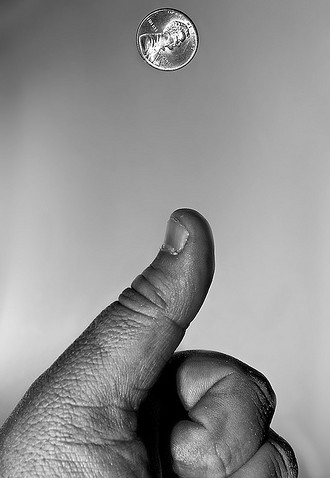We gamers like to think of ourselves as highly rational creatures. We pride ourselves on our logic, our strategic victories, our tactical know-how, but how sensible are we, really?
Not very, it turns out.
Humans, while having the unique opportunity to understand the universe around us, are surprisingly adept at misleading ourselves. We’re notoriously bad with odds and and percentages, and we often can’t trust our own eyes. Even our attempts to rely on “cold, hard facts” are often led astray by our own biases. We believe that the odds will be ever in our favor and that the next roll will have to be a natural twenty.
There’s not much we can do about this. It’s as hard-wired into our brains as our ability to recognize faces, and it generally doesn’t do too much damage. As a gamer, though, it helps to understand the world, and the odds, that you’re facing. While nothing can transform your brain into an efficient, logical supercomputer, knowing your own weaknesses is the first step toward correcting (or at least controlling) them.
Below, I examine The Gambler’s Fallacy, one of the most common logical missteps in the gaming world. It’s been around for as long as we have, but it’s only relatively recently that we’ve become aware of and put a name to this mental phenomenon.
The Gambler’s Fallacy
If you roll three twos in a row, the next number to come up just can’t be another two, can it?
Well, yes, it can. We all know that the probability of rolling any particular number on a six-sided die is 1/6. This is true regardless of what you rolled before, or how many times it was rolled. Similarly, if you flip a coin, the probability of it landing heads-side-up is always just about 1/2, or 50%. If you flip a coin ten times and it lands heads up all ten times, the probability of it landing heads-side-up on the eleventh flip is still 50%.
This is what the math tells us.
 What our mind tells us, however, is that it’s impossible for something that depends on pure chance to remain consistent, or a random process becomes predictable the more it is done.
What our mind tells us, however, is that it’s impossible for something that depends on pure chance to remain consistent, or a random process becomes predictable the more it is done.
I read an anecdote a few years ago about a math professor who divided her students into three teams. She told the teams that one of them would be asked to flip a coin fifty times and to record the results. The other two teams would be asked to pretend that they had flipped the coin fifty times, but to actually make up the results. The professor asked her assistant to assign the teams, then she would leave the room. When she returned, she would be able to guess which group had truly flipped a coin and which groups had fabricated their coin flips.
When she returned, she listened to all three sets of results, then easily chose the group with the real coin flips. The class was amazed.
How had she managed to tell so easily? The true result set was the only one that contained a string of more than three heads in a row. So, that group had flipped the coin and it had landed heads-up more than three times in a row.
The other groups figured that the odds of a coin landing heads-up more than three times in a row were so small that they would be a dead giveaway that the flips were made up. In fact, the opposite was true.
The Mental Games We Play
This illustrates a few things about the way we, as gamers and as humans, think.
 First of all, we tend to believe that the world is balanced. This is called the “Just World Hypothesis”, but it has to do with more than just good or evil. Part of the hypothosis/fallacy states that the universe is ultimately fair, and that actions will reap appropriate rewards. So, if you commit a truly evil act, something equally horrible will one day happen to you. What goes into the universe must eventually come out. It’s actually a lot like karma.
First of all, we tend to believe that the world is balanced. This is called the “Just World Hypothesis”, but it has to do with more than just good or evil. Part of the hypothosis/fallacy states that the universe is ultimately fair, and that actions will reap appropriate rewards. So, if you commit a truly evil act, something equally horrible will one day happen to you. What goes into the universe must eventually come out. It’s actually a lot like karma.
So, if you flip a coin seven times and it lands heads-up each and every one of those times, that’s a lot of heads-up coins to put into the world. The world feels the pressure, and must balance out the abundance of heads over time. The “law” does not state that this happens right away. So, you won’t necessarily flip seven tails immediately after. But, the idea goes, that over time, little by little, the flips will even out.
This is, of course, totally false. The universe cares as much for balance as it does for the ant you stepped on yesterday. There is no supernatural force that keeps the heads-to-tails ratio in check, and most of us acknowledge this. But, we always still think that next flip is going to be different.
The Gambler’s Fallacy also plays into another faulty thought mechanism that we have: the Representative Heuristic. That is, we tend to believe that samples of populations are actually true representative of their populations. So, say you had a dice bag full of 50 red dice and 50 blue dice. If you were asked to reach into the bag to pull out ten dice, you would expect roughly 50% of your sample to be red and 50% to be blue. We recognize that this isn’t going to be perfect, so if we pull out six red dice and four blue dice instead, we won’t think anything is off. Yet, if we pull out eight red dice and only two blue dice (a situation that is totally possible), we’re likely to misinterpret the actual contents of the bag.
These notions are useful to be aware of in our general activities, but they’re also very useful in gaming as well. While we may not be as naturally logical creatures as we’d like to think, we at least have the ability to recognize where we’re being led astray. A little knowledge of our own weaknesses can go a long way, and this understanding can hopefully make us better gamers.
![]()
Erin Ryan is a regular contributor to the site. Do you come across other logical fallacies in your gaming? Feel free to share them with us over on our forums!
Photo Credits: Brain Scan by Liz Henry; Penny Flip by jeff_golden.
